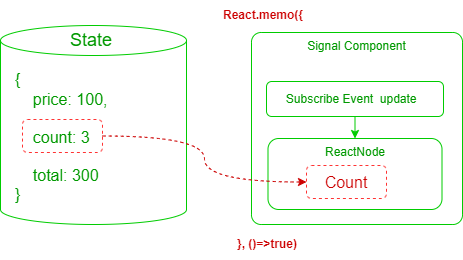Status signal component
about
The state data is encapsulated into a signal component. When the state data changes, the redirect component is automatically rendered.

interface SignalComponentType<State extends Dict>{
// 指定状态数据路径
(selector: string):React.ReactNode
// 返回状态数据的函数
(selector: (state:ComputedState<State>)=>React.ReactNode):React.ReactNode
}prompt
You only need to specify the path of the status digital library or provide a function that returns the status data.
Synchronous signal component
use $ ('<State Path>') will Status data is directly encapsulated as signal components when the status data changes, the re -rendering of the signal component is automatically triggered.
Note
Be updated Age at the same time, the entire color block will not change to re -renders.
Combination synchronous signal component
use $((state)=>{.....}) the combination of multiple status data is created as a signal component. When the dependent state data changes, the signal component will automatically trigger re -rendering.
Asynchronous computing signal component
Use $ ('<State Path>') will Status data is directly encapsulated as signal components at this time, if the status data is an asynchronous data object AsyncComputedValue at that time, the object contains loading,error,value properties.
- When the path specifies an asynchronous computing attribute, the signal component created will automatically add
valueproperty. Therefore, the above$('order.total')and$('order.total.value')it's equivalent.
Note
$('order.count')and$('order.total.value')it is equivalent. When creating a signal component, if the target is foundAsyncComputedValueautomatically addvalue.- You may have noticed that the rendering color block components on the current page will not change. This is the charm of the fine particle -level update of the signal component. When the state changes, the rendering of the component is limited inside the signal component.